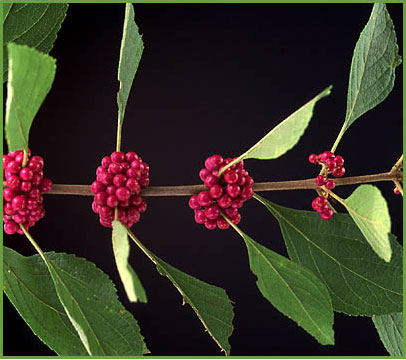Beauty Berry
Callicarpa spp.
Family: Lamiaceae
Natural History
 Beautyberry with fruits
Beautyberry with fruits
Photo credit: Larry Korhnak, University of Florida
Beautyberry grows in many environmental conditions from moist and shady to open and dry. Across this range of habitats, it most frequently occurs under open pine stands. Beautyberry is found in most of the southeast, between Florida and Texas in the south, to Maryland, Missouri, and Oklahoma in the north.
Beautyberry occurs in both old forests and in new pine plantations. It tolerates fire, and often spreads in periodically burned pine stands. The fruit and seeds are eaten and dispersed by more than forty species of songbirds, deer, raccoons, opossums, armadillos, and numerous small rodents. The leaves are also a common food source for white-tailed deer.
Small flowers blossom in midsummer in dense clusters along the new stems. The petals are bright pink to lavender. Later, clusters of small, but bright, violet berries dot the forest from August to January. Although beautyberry fruits most heavily with full sun, it will grow fine in partial shade also. A very distinctive feature of beautyberry is the strong, unpleasant aroma of crushed leaves.
The two most common species of beautyberry are our native American beautyberry (Callicarpa americana) and purple beautyberry (Callicarpa dichotoma). Purple beautyberry is a more compact, neater shrub but otherwise the two are very similar. This genus was formerly classified in Verbenaceae and some older references will still give that family name.

